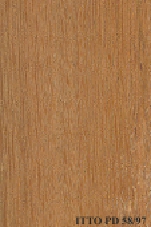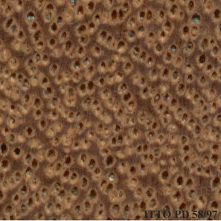
KAMERERE (Eucalyptus deglupta)
Trade Name
Kamerere
Scientific Name
Eucalyptus deglupta Blume
Family
Myrtaceae
Common Names
Mindanao gum (Australia); Komo (Papua New Guinea); Eucalyptus (Malaysia); Banikag (Philippines); Leda; Leda (Indonesia); Bagras (Philippines); Kamarere (Solomon Islands); Kamarere (Papua New Guinea)
Description Of The Tree
Botanical Description
It is a huge evergreen tree of up to 60 m tall. The bole is generally of good form, up to half or two thirds of the tree height. Diameters up to 240 cm are reported, sometimes with buttresses of 3 to 4 m high.
Natural Habitat
Eucalyptus deglupta grows typically in pure stands, from the sea level up to 1,800 m of altitude.
Natural Distribution
It is native to the Philippines and other western Pacific islands.
Plantations Available?
It is favored as a plantation species throughout the world in lowland humid tropics.
Wood Identification
Anatomic Description Of Wood
Wood diffuse porous. Vessels in diagonal and/or radial pattern. Vessels exclusively solitary (over 90%). Tyloses common. Vestured pits. Vessels per mm2 5 to 20. Vessel-ray pits reticulate and/or foraminate. Vascular/vasicentric tracheides present. Simple perforat Apotracheal axial parenchyma diffuse and/or diffuse in aggregates. Paratracheal axial parenchyma scanty and/or vasicentric. Prismatic crystals in chambered axial parenchyma cells and/or in fibers. Rays more than 10 per mm (abundant). Homogeneous rays and/or sub-homogeneous rays (all ray cells procumbent). Fibers with distinctly bordered pits.
-
 Wood Macro Photo Tangential Plane
Wood Macro Photo Tangential Plane
-
 Wood Micro Photo Of Transversal Section
Wood Micro Photo Of Transversal Section
Availability
Cites Status
Unrestricted
General Wood Description
Odor
It has no taste or odor.
Color
The sapwood varies from pale white to light pink. The heartwood varies from light red to cocoa brown.
COLOR INDEX (1=Black, 7=Light yellow,white)
4
Grain
It is partly straight, partly interlocked.
Texture
The texture varies from moderately coarse to coarse.
Luster
The heartwood has a moderate luster.
Natural Durability
It is moderately resistant to fungal attack if exposed above the ground, but liable to termite and marine borer attack.
Natural durability index (1= Very high durability, 7=Vey low durability)
3
Silica Content
Silica Content: It is non-siliceous. Silica Value: 0
Resistance To Impregnation
The sapwood is reported to be easy to preserve but the heartwood is untreatable.
Wood Physical Properties
Basic Density or Specific Gravity (O.D. weight/vol. green) (g/cm³)
0.68
Air-dry Density (Weight and volume at 12%MC) (g/cm³)
0.76
Total shrinkage Tangential (Saturated to 0%MC) (%)
7.5
Total shrinkage Radial (Saturated to 0%MC) (%)
4.7
Recommended Dry Kiln Schedule
UK-E; US-T6-D2
Dimensional stability ratio (Total Tangential Shrinkage %/Total Radial Shrinkage %)
1.6
Wood Chemical Properties
Wood Mechanical Properties
Bending Strength (MOR),12%MC (kgf/cm²)
966
Stiffness (MOE) 12%MC (kgf/cm²)
164799
Compression parallel to fiber 12%MC (kgf/cm²)
607
Janka hardness (side) 12%MC (kgf)
156
Janka hardness (end grain) 12%MC (kgf)
167
Workability
Sawing
This species is easy to saw.
Rotary Veneer Cutting
It can be peeled if steamed.
Sliced Veneer
It can be peeled if steamed.
Machining
It works well with hand and machine tools, although it has a slight tendency to tear out in machining.
Planing
This species is easy to plane.
Moulding
Molding operations are easy to fair.
Turning
30
Boring
It is easy to bore.
Mortising
Mortising is reported to be easy.
Nailing
Pre-bore is recommended for nailing to avoid splitting.
Gluing
The timber is reported to glue well.
Finishing
With care a good finishing can be obtained.
Staining
Staining of this species is reportedly easy.
Coatings
Painting or varnishing of this species is reportedly easy.
Polishing
Wood of this species is easy to polish.
Response To Hand Tools
This species is reported to be easy to work with hand tools.
REFERENCED USES
End Uses Summary
HOUSING GENERAL, flooring, frames, panelling, FURNITURE AND CABINETS, PLYWOOD AND VENEER, TURNING, SPORTS, TOOLS, tool handles, agricultural tools, PACKING, CONTAINERS, cooperage, truck bodies, truck flooring, NAVAL CONSTRUCTION, OTHER AND MUSICAL INSTRUMENTS, handicrafts, moldings, paper
General Housing
- 10 - Silica in Timbers
Flooring
- 14 - Handbook of Hardwoods
Frames
- 16 - Woods of the World
Paneling
- 18 - W3TROPICOS Missouri Botanical Garden
Furniture Cabinets
- 21 - Tropical timbers of the world. Part III-Southeast Asian and Oceanian Species.
Panels, Veneers
- 25 - Directory of Timber Trade Malaysia
Turning
- 30 - Embassy of Honduras in Japan
Sports
- 38 - Annual Review and Assessment of the World Timber Situation 1998-ITTO
Tools
- 42 - Utilización Industrial de Nuevas Especies Forestales en el Perú.
Tool Handles
- 43 - Maderas de Bolivia (Características y Usos de 55 Maderas Tropicales)
Agricultural Tools
- 44 - Atlas of Peruvian Woods
Packing
- 45 - Recopilación y Análisis de Estudios Tecnológicos de Maderas Peruanas
Containers
- 50 - Properties of imported tropical woods
Cooperage
- 51 - Recopilacion de propiedades mecanicas de maderas creciendo en Chile
Truck Body
- 53 - Timbers of the New World
Truck Flooring
- 54 - Bulletin of the Government Forest Experiment Station N.157: Identification of Tropical Woods
Shipbuilding
- 55 - Tropical Timber Atlas of Latin America
Handcraft
- 66 - Maderas latinoamericanas. VII. Caracteristicas anatomicas. propiedades fisicomecanicas, de secado, y tratabilidad de la madera juvenil de Cordia alliodora (Ruiz & Pav. Oken.)
Molding
- 79 - Padronização da Nomenclatura Comercial Brasileira das Madeiras Tropicais Amazônicas, Sugestão
Paper
- 82 - Compilation of Data on the Mechanical Properties of Foreign woods (Part 2) Central and South America.
Please Provide Information To View Producer Information